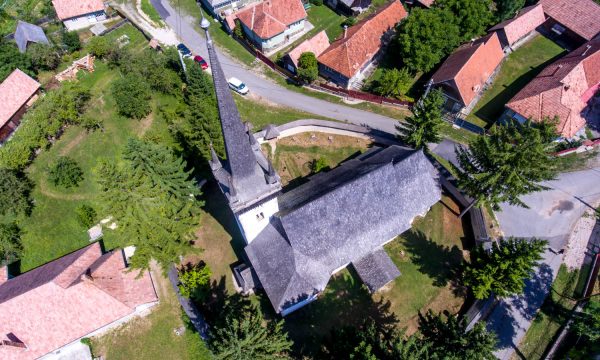Mănăstireni is a village located in the western area of Călata (Hu: Kalotaszeg) region, on the shore of the river Căpușu (Hu: Kapus). Until the 15th century it appeared as a monastery in the written documents. Starting from the first decade of the 15th century its name changed to Gyerőmonostor. The village’s other appellation, Oláhmonostor, appears first in 1486.

The Hungarian area was located north from the river, whereas the Romanian area was situated south from it. During the medieval times the village was a divided property belonging mostly to the people related to the Mikola family: the Gyerőmonostori Kabos, Kemény, Radó and respectively Szamosfalvi Gerő and the Mikola families. The name of the village possibly relates back to the family monastery of the Mikolas. Other than its proprietor, we have absolutely no information about the monastery. Our only reliable information comes from the field of art history: the research done in today’s reformed church has created a connection between some of the 13th century carvings discovered and the monastery. The monastery appears in written documents for the first time in 1332 (villa Monostur). Judging from the tithe paid by Peter parson, Mănăstireni was supposedly a small and negligible village in the 14th century. This early written document also tells us that it belonged to the Episcopate of Oradea (Hu: Várad); administratively, on the other hand, to the historic county of Bihar. At the beginning of the 14th century it was transferred to the historic Kolozs county, together with the lordship of Bologa (Hu: Sebesvár).
One of the area’s most powerful proprietor was the István Monostori who remonstrated against the captain of Bologa in the 14th century and gave a loan to János Gyerő in exchange for a doubled redemption fee. We assume that the Gyerő family succeeded in possessing some of the region by the end of the 14th century, because from the following century the village appears as Gyerőmonostor in the written sources.

Another significant personality from the area is János Kemény. He married Ilona from Harangláb, and to top it all, he moved into the manor-house of Hărănglab (Hu; Harangáb), much to the annoyance of the wife’s family. János Kemény was the one who built the chapel of the village, which gained indulgence in 1433 by Pope Eugene III. The letter of indulgence tells us that the chapel was built in honour of a saint king and was located inside Mănăstireni. Starting from the 15th century, a Saint Ladislaus chapel figures in the sources, but that is said to have been located outside the village, on top of a hill. In 1491, on the day of Saint George, Péter Kemény marched to the chapel together with his parson and a cross, but was attacked and wounded by the other proprietor of the region, Antal Dobszai and his men. This incident sparked off a conflict which continued for years. Nevertheless, the tale of the chapel remains unknown. The last time it appears in the documents is in 1493.
